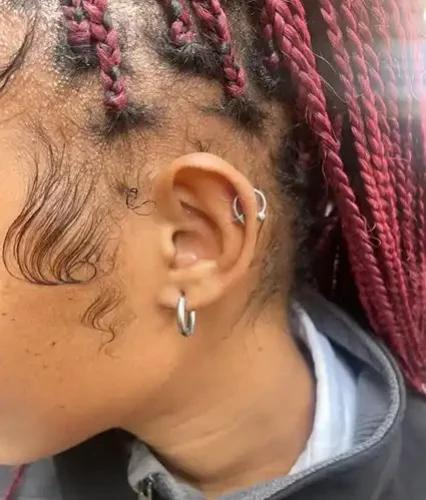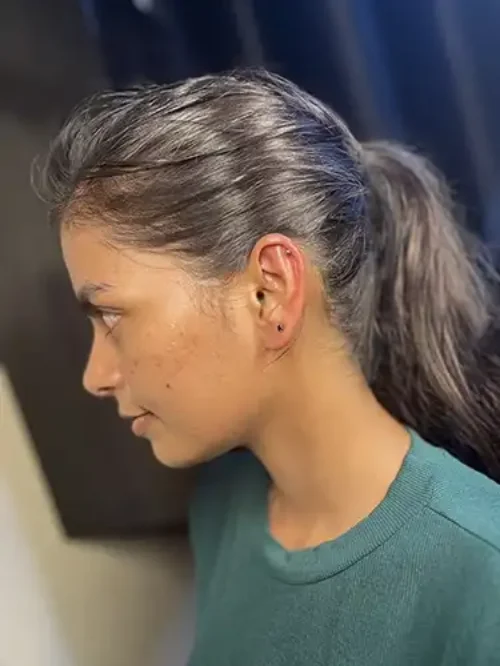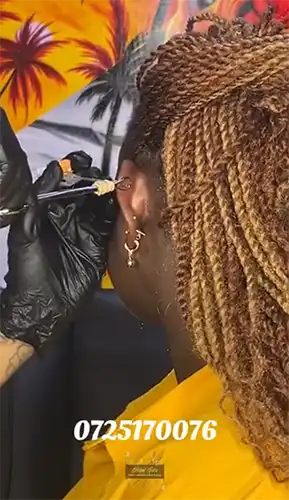Cartilage (Helix) Piercing in Nairobi, Kenya
A cartilage (helix) piercing is a type of ear piercing done on the upper cartilage of the ear, along the outer edge. Unlike earlobe piercings, it goes through the harder, non-fleshy part of the ear, making it a more unique and stylish option for those looking to add flair to their look.
Cartilage Piercings
Key Features of a Helix Piercing:
- Placement:
– Located on the outer rim of the ear, above the earlobe.
– Can be a single piercing or part of a set, like a double or triple helix. - Jewelry Options:
– Starter jewelry is usually a simple stud to accommodate swelling.
– Once healed, you can wear hoops, cuffs, or intricate designs. - Pain Level: Typically more painful than a lobe piercing but manageable, as the cartilage has fewer nerve endings.
- Healing Time: Full healing takes about 6 to 9 months, depending on aftercare and individual healing rates.
Why Choose a Helix Piercing?
- Style Versatility: Perfect for layering with other ear piercings for a curated look.
- Unique Aesthetic: Stands out from standard earlobe piercings.
- Customization: Endless options for expressing your personal style.
Types of Helix Piercings
A helix piercing offers a variety of placement options on the upper cartilage of the ear, allowing you to customize your look. Here are the most popular types of helix piercings:
- Standard Helix Piercing
– Location: The outer upper rim of the ear.
– Style: Single placement or multiple piercings for a layered effect.
– Jewelry Options: Studs, small hoops, or simple barbells. - Double and Triple Helix Piercing
– Location: Two or three piercings stacked along the helix.
– Style: Creates a symmetrical and eye-catching look.
– Jewelry Options: Coordinating studs or hoops for a cohesive style. - Forward Helix Piercing
– Location: The cartilage near the ear’s tragus, at the front of the ear’s curve.
– Style: Ideal for single or multiple placements.
– Jewelry Options: Dainty studs or mini barbell designs. - Industrial Piercing
– Location: A single barbell connects two helix piercings across the ear.
– Style: Bold and edgy, great for a statement look.
– Jewelry Options: Industrial barbells with decorative ends. - Anti-Helix Piercing (Snug Piercing)
– Location: Inner cartilage fold, parallel to the standard helix.
– Style: Subtle yet unique.
– Jewelry Options: Small curved barbells or studs. - Mid-Helix Piercing
– Location: Middle section of the helix cartilage.
– Style: A great option for jewelry layering.
– Jewelry Options: Hoops, studs, or minimalist designs.
Cartilage (Helix) Piercing Procedure: What to Expect
A cartilage (helix) piercing is a stylish way to accessorize, but it’s essential to understand the process to ensure safety and proper healing. Here’s a detailed breakdown:
Step 1: Preparation
- Choose a Professional Studio: Select a licensed studio with experienced piercers and strict hygiene standards.
- Jewelry Selection: Opt for starter jewelry, typically a small stud or labret bar made from hypoallergenic materials like titanium or surgical steel to minimize irritation.
Step 2: Cleaning and Marking
- Sterilization: The piercer will disinfect your ear and surrounding area thoroughly.
- Marking the Spot: The piercer will mark the exact placement of the piercing on the helix. You’ll be asked to confirm the position to ensure it matches your vision.
Step 3: The Piercing Process
- Equipment Used: A sterile, hollow piercing needle (never a gun, as guns can cause trauma to cartilage tissue).
- Procedure:
– Our piercer carefully inserts the needle through the marked spot on the helix.
– The chosen jewelry is inserted immediately after the needle.
– The process is quick, typically lasting only a few seconds. - Pain Level: Most people describe the sensation as a sharp pinch followed by mild pressure.
Step 4: Aftercare Instructions
The piercer will provide detailed aftercare guidelines, including:
- Cleaning Routine: Clean the area twice daily with a saline solution or a piercing aftercare spray.
- Avoid Touching: Refrain from twisting, fiddling, or sleeping on the piercing to reduce irritation.
- Healing Time: Cartilage piercings take 6–9 months to heal fully. Be patient and consistent with aftercare.
What to Avoid Post-Piercing
- Swimming: Steer clear of pools, hot tubs, and open water to prevent infection.
- Heavy Earrings: Stick to lightweight jewelry during healing.
- Alcohol/Peroxide: Avoid using harsh cleaning agents that can dry out or irritate the piercing.
Why Use a Needle Instead of a Gun?
- Using a needle:
– Ensures precision and cleaner puncture.
– Reduces trauma to cartilage tissue.
– Lowers the risk of complications like swelling or scarring.
Considerations before getting an Helix Piercing.
Before getting a helix piercing, it’s important to carefully consider several factors to ensure you make an informed decision and are prepared for the process and aftercare. Here are some considerations to keep in mind:
- Professional Piercing Studio: Research reputable piercing studios in your area. Look for studios with experienced, professional piercers who follow strict hygiene and safety practices.
- Piercer’s Qualifications: Ensure that the piercer is trained and experienced in performing helix piercings. Ask to see their portfolio of previous work.
- Placement and Design: Discuss the placement and design of the helix piercing with your piercer. Choose a location and jewelry style that suits your preferences and complements your ear’s anatomy.
- Pain Tolerance: Be prepared for some pain and discomfort during the piercing process. While it’s typically brief, everyone’s pain tolerance is different.
- Healing Time: Understand that helix piercings can take several months to fully heal. Proper aftercare is crucial during this period.
- Aftercare Commitment: Be ready to follow the aftercare instructions provided by your piercer diligently. This may include cleaning the piercing with a saline solution and avoiding touching the piercing with dirty hands.
- Swelling and Redness: Expect some swelling and redness around the piercing site, especially in the initial days and weeks following the piercing.
- Jewelry Options: Discuss jewelry options with your piercer. Choose high-quality jewelry made from materials such as surgical steel, titanium, or biocompatible materials to minimize the risk of complications or allergic reactions.
- Infection Risk: Understand the risk of infection and other complications. Proper aftercare is essential to minimize these risks.
- Rejection and Migration: Be aware that helix piercings can be prone to rejection or migration, where the body pushes the jewelry out over time. Proper jewelry choice and aftercare can help reduce these risks.
- Lifestyle Considerations: Consider how the piercing may impact your daily life, such as sleeping on that side, wearing headphones, or participating in sports or activities that could put stress on the piercing.
- Visibility and Style: Helix piercings are quite visible and can be a fashion statement. Consider whether this level of visibility aligns with your personal style and whether it’s acceptable in your workplace or school.
- Future Plans: Consider any future plans or career goals that may be affected by the piercing. Some professions or workplaces have strict policies regarding visible piercings.
- Consultation: Before getting the piercing, have a consultation with your chosen piercer to discuss your expectations, ask any questions, and receive personalized advice.






Cartilage (Helix) Piercings FAQ’s
Cartilage (Helix) Piercing Aftercare Guide
Proper aftercare is essential for ensuring your helix piercing heals smoothly and minimizes the risk of infections or complications. Here’s everything you need to know about caring for your new piercing:
- Cleaning Your Piercing
– Use Saline Solution: Clean the piercing twice daily using a sterile saline solution or a piercing aftercare spray. Avoid alcohol, hydrogen peroxide, or harsh antiseptics, as they can irritate the area.
– How to Clean:
→ Wash your hands thoroughly.
→ Soak a cotton pad in the saline solution and gently dab around the piercing.
→ Avoid twisting or removing the jewelry during the cleaning process. - Avoid Touching the Piercing
– Only touch the piercing with clean hands when cleaning it.
– Avoid playing with or twisting the jewelry, as this can introduce bacteria and delay healing. - Be Gentle While Sleeping
– Avoid sleeping on the side with the piercing to reduce pressure and irritation.
– Use a travel pillow to keep pressure off the ear during sleep. - Protect Your Piercing from Irritants
– Avoid Water Exposure: Keep the piercing away from swimming pools, hot tubs, and open water to prevent infections.
– Steer Clear of Hair Products: Be cautious when using hair sprays, shampoos, or other products near the piercing. - Monitor Healing Progress
– Healing Time:
→ A helix piercing typically takes 6 to 9 months to heal fully.
→ The outer part may seem healed sooner, but the inside takes longer.
– Signs of Normal Healing: Slight redness, mild swelling, and occasional crusting are normal in the early weeks.
– Warning Signs of Infection: Persistent swelling, intense pain, warmth, or yellow/green discharge are signs of infection. Contact your piercer or a healthcare professional if you notice these symptoms. - Jewelry Tips
– Starter Jewelry: Avoid changing your starter jewelry until the piercing is fully healed.
– Material: Use hypoallergenic materials like titanium, surgical steel, or gold to avoid allergic reactions.
Long-Term Maintenance
Even after healing, clean the piercing regularly and remove buildup from jewelry to keep it fresh.
Cartilage (Helix) Piercing Jewelry: Options and Tips
Choosing the right jewelry for your helix piercing is essential for comfort, healing, and style. Here’s a guide to help you make the best choice.
Starter Jewelry
When getting a helix piercing, your piercer will recommend starter jewelry designed for comfort and healing:
Material:
- Titanium: Hypoallergenic and lightweight, ideal for sensitive skin.
- Surgical Steel: Durable and affordable, but not suitable for nickel-sensitive individuals.
- Solid Gold (14k or higher): A luxurious, hypoallergenic option. Avoid gold-plated jewelry during healing.
Styles:
- Flat Back Studs: Comfortable and secure, minimizing snagging and irritation.
- Labret Bars: Great for initial healing due to their smooth backing.
Jewelry Styles After Healing
Once your helix piercing is fully healed (typically 6–9 months), you can explore a variety of jewelry options:
- Studs (Classic and versatile): Choose gemstones, minimalist designs, or intricate shapes to suit your style.
- Hoops:
– Simple seam rings or decorative captive bead rings are popular choices.
– Ensure the hoop fits snugly but doesn’t apply pressure to the piercing. - Clickers:
– Easy-to-use hoops that snap into place.
– Available in sleek, plain designs or with detailed embellishments. - Cuffs: Wrap around the ear for a bold look, often paired with other piercings.
- Curved Barbells: A stylish option that adds dimension to your curated ear look.
Jewelry Sizing
- Gauge (Thickness): The standard gauge for helix piercings is 16G (1.2mm) or 18G (1mm). Confirm with your piercer before purchasing jewelry.
- Diameter (Hoops): For hoops, the diameter usually ranges from 6mm to 10mm, depending on ear anatomy and placement.
Jewelry Care Tips
- Clean Regularly: Keep your jewelry clean, even after healing, to avoid buildup.
- Avoid Cheap Metals: Nickel-containing or low-quality metals can cause irritation or allergies.
- Secure Fastenings: Ensure screws or clasps are tightened properly to prevent loss.
Combine different helix jewelry pieces with lobe and conch piercings for a curated ear look. Mix metals, gemstones, and textures to express your personality.
Cost of a Cartilage (Helix) Piercing in Nairobi, Kenya
The cost of a helix (cartilage) piercing varies based on factors such as location, the studio’s reputation, the piercer’s experience, and the type of jewelry selected. Here’s a breakdown to help you understand the potential expenses:
Average Cost:
- The average cost for a professional helix piercing is Ksh. 1,500 to KSh. 2,500. Prices may be higher for premium jewelry or in high-end studios.
Factors Influencing the Price:
- Geographical Location: Prices can differ depending on the region and local market rates. Rebel Inks Tattoos, Tattoo Removal, and Body Piercings Parlour is located in the heart of the Central Business District (CBD) in Nairobi, Kenya, and is easily accessible to both locals and foreigners in the country.
- Studio Reputation: Renowned studios with experienced piercers may charge higher fees. At Rebel Inks Tattoos, Tattoo Removal, and Body Piercings Parlour we have experienced professionals who offer quality and premium services.
- Jewelry Selection: Opting for high-quality materials like titanium or gold can increase the overall cost.
- Additional Services: Some studios may include aftercare products or follow-up consultations in the price, while others might charge extra.
What’s Included in the Cost?
- Piercing Procedure: Performed by our trained professional with sterilized tools.
- Starter Jewelry: Usually a basic stud or barbell made from a safe, hypoallergenic material.
- Aftercare: At Rebel Inks Tattoos, Tattoo Removal, and Body Piercings Parlour we may include aftercare products, such as saline sprays, in the price.
Additional Considerations:
- Aftercare Products: Purchasing saline solutions or specialized cleaning products may add to the overall expense.
- Multiple Piercings: At Rebel Inks Tattoos, Tattoos Removal, and Body Piercings we might offer discounts for multiple piercings done in a single session.
- Consultation Fees: While many studios provide free consultations, it’s advisable to confirm this beforehand.
- Jewelry Upgrade: Opting for custom or luxury jewelry may add Ksh. 500 to Ksh. 1,000
Cartilage (Helix) Price Breakdown Table
Component / Service | Estimated Cost (KSh) | Notes / Details |
Procedure + basic surgical‑steel or titanium stud | 1,500 – 2,000 | Typical in mid-range rates |
Premium titanium or niobium jewellery upgrade | 500 – 1,000 | For hypoallergenic or design jewelry |
Gold or custom designer jewellery | 1,500 – 3,000 | Depends on size, gems, and material |
Aftercare kit (saline spray, balm) | 300 – 500 | Often optional or included |
Follow-up / downsizing visit | 200 – 1,000 | Downsizing after swelling or jewelry change |
Tips for Choosing the Right Studio
- Prioritize Hygiene: Ensure the studio uses sterilized equipment and follows strict hygiene protocols.
- Check Reviews: Read customer reviews to gauge the quality of service.
- Ask Questions: Inquire about what’s included in the price and the type of jewelry provided.
Looking for a high-quality helix piercing that fits your budget? Contact our studio for professional service, premium jewelry, and expert aftercare advice—all at competitive rates.
Possible Side Effects of a Cartilage (Helix) Piercing
While a helix piercing can be a stylish addition, it’s essential to be aware of potential side effects. Proper aftercare can minimize these risks, but here are some common and uncommon issues to watch for:
- Pain and Swelling
– What to Expect: Mild pain, redness, and swelling are normal during the initial days after piercing.
– When to Be Concerned: Persistent pain or swelling lasting more than a week may indicate infection or irritation. - Infections
– Symptoms:
→ Redness, warmth, and tenderness around the piercing.
→ Pus or discharge (yellow or green).
→ Fever in severe cases.
– Prevention:
→ Follow aftercare instructions diligently.
→ Avoid touching the piercing with dirty hands.
→ Keep the piercing dry and clean. - Cartilage Bumps
– Types:
→ Hypertrophic Scarring: Raised bump near the piercing caused by irritation or trauma.
→ Keloids: Larger, harder scars that extend beyond the piercing site (more common in those prone to keloids).
– Prevention/Treatment:
→ Avoid sleeping on the piercing.
→ Use saline soaks regularly.
→ Contact Our Piercer for persistent bumps. - Prolonged Healing
– Reason: Cartilage has a limited blood supply, which slows healing.
– Normal Healing Time: 6 to 9 months. Delays can result from improper care or interference (e.g., touching or twisting the jewelry). - Allergic Reactions
– Cause: Jewelry made from nickel or other reactive metals.
– Symptoms: Itching, redness, or rash around the piercing.
– Solution: Use hypoallergenic materials like titanium, surgical steel, or 14k+ gold. - Piercing Rejection or Migration
– What Happens: The body may push the jewelry out, causing it to move or fall out.
– Prevention:
→ Choose the correct gauge and jewelry type.
→ Avoid trauma to the piercing site during healing. - Embedded Jewelry
– What Happens: Jewelry sinks into swollen tissue, usually due to inappropriate sizing or excessive swelling.
– Solution:
→ Visit a professional piercer immediately.
→ Replace the jewelry with a longer bar or stud to accommodate swelling. - Chondritis (Cartilage Infection)
– Rare but Serious: Severe cartilage infection that may require medical attention.
– Symptoms: Intense pain, swelling, and redness spreading beyond the piercing site.
– Treatment: Seek medical care for antibiotics or other interventions.
How to Reduce Side Effects
- Choose a reputable studio that uses sterilized equipment.
- Follow aftercare instructions closely, including cleaning twice daily with saline.
- Avoid touching, twisting, or removing the jewelry during healing.
- Sleep on the opposite side to avoid pressure on the piercing.
Get In Touch
For more information on the list above and any other special services,please call or come in for free consultation
Testimonials
After he pierced my industrial piercing and seeing his amazing work, I feel even more excited about getting my tattoo with him in January. I’m really looking forward to it!
I am extremely happy with my new 'Safari' tattoo from Eric at Rebel Inks! The quality of the artwork is fantastic. Eric is a true professional and an amazing artist.
The preparation and design process was thorough and collaborative. He was very patient with my specific requests, including making sure all the elements, which hold personal meaning, were perfect.
The service was friendly and highly professional from start to finish. Despite the 8-hour session, Eric was a pleasant person to spend the time with.
The aftercare guidance and follow-up have been excellent and careful, which has made the healing process easy and better than expected.
I highly recommend Eric for anyone looking for a thoughtful, talented, and caring tattoo artist.
I recommend them 💯
I would definitely recommend if you’re thinking of getting a piercing!
The staff were super friendly, explained everything clearly, and made me feel so at ease. They answered all my nervous questions (and I had many questions),
They walked me through the whole process, gave detailed aftercare instructions, and even followed up afterward to check how I was healing 🫶
Clean, professional, and full of good vibes.
Would 100% recommend . Definitely making a second trip here.
This was the second tattoo I got and I wish I could have come to Eric for my first one! He gave me really great after-care directions for the tattoo as well as a little jar of his own Vaseline-type stuff to put over my tattoo while it was healing! He even put second skin over my tattoo so that I didn’t have to worry about it for the first few days. Now THAT’S good service. My first tattoo artist didn’t do none of that lol.
After the session Eric didn’t rush me and my friend out, he chatted with us and even when he found out I was an artist too— really encouraged me to keep creating and to find a community of artists to support me. I almost cried because I’ve had such a hard time with my own art the past couple of years, it meant so much to me to have a fellow very talented artist say that to me. 🤍🤍🤍
Eric you’re amazing, don’t ever stop creating and just know you’ve impacted lives all over the world!🫶🏻 thanks so much for everything!!
From the moment I walked in, Eric was professional, welcoming, and attentive. He made sure I was comfortable throughout, provided everything I needed, and explained every step of the process. The tattooing itself was unbelievably smooth - I genuinely felt no pain compared to my previous tattoos over the last 22 years.
Eric also gave me excellent aftercare guidance and products, and thanks to that, my tattoo healed beautifully. The attention to detail, precision, and shading are absolutely stunning. This is hands-down the best tattoo I've ever had, and I will be flying back to Nairobi for any future ink.
If you want incredible art, a professional experience, and a talented artist who truly cares about his clients, Rebel Ink is the place to go!
From start to finish, the service was exceptional. The piercer was professional, knowledgeable, and made me feel completely comfortable. The cleanliness of the place was above and beyond — everything was spotless and hygienic, which really put me at ease. Highly recommend for anyone considering a piercing!
Shout out to Eric😘
We ended up changing the jewelry three times to ensure I had the best fit and avoided any signs of rejection, and he always listened to my suggestions as a client, which I really appreciated. Now, three months in, my piercing is healing beautifully, with no sign of rejection. Highly recommend for anyone who values a piercer who cares about your comfort and healing journey!
What stood out the most was the aftercare Eric checked in with me even three weeks later to see how the tattoo was healing. That kind of follow-up shows how much he truly cares about his work and his clients.
I’m very satisfied and will definitely be coming back for my next piece. Highly recommend!
The piercing wasn't as painful as I had thought and the process was quick and satisfactory. I love it!!!
The piercing is healing well thanks to the aftercare instructions and follow-up. I would highly recommend Rebel Inks
Eric also did a belly button piercing for a friend, guiding her through the process, doing the piercing and then explaining the after care to her.
The shop is on the 3rd floor, with the entrance to the stairs near an alleyway on the left. The shop is perfect size, clean, and attractive looking. The mural is pretty dope.
Thank you for the amazing service! 🔥👅✨
I got piercibgs there and the process was really good. My biggest concern was hygiene but that wasn't an issue at all, they use new needles and they sanitize them.
The service itself was also welcoming.
I was informes of everything i needed to know beforehand.
10/10 would recommend!
Eric was so calm and patient with my almost 2 year old lady. It was such a clean and hygienic process. We will definitely be back for our second rounds of piercings and maybe even another tattoo!
They assess the area before any art and advise one accordingly. They also give one post clean up process and also do a check up after the body art projects. Overall, I loved my experience and I’m hooked. 👍
Will definitely come back next time I’m in town 🙂
He listened to what I actually wanted and made sure he could fit in the time before I flew back home.
The shop is clean & private and is easy enough to find.
Eric has even checked in a couple of times since to make sure all is good.
I would totally recommend Eric! I absolutely love my Elephants!
I had a very easy healing period and always follow up from Eric to check on my progress...I would highly recommend if you are a first timer because from my experience all went very well and attention to detail
Thank you for a good job and looking forward to send all my friends your way
And all the best with the new year 2025!
From the moment I walked in, the staff was super friendly and made me feel at ease. The studio had a clean, professional atmosphere, which immediately put me at ease. My piercer was incredibly skilled and explained every step of the process, ensuring I was comfortable the entire time. The piercing was quick and practically painless, and the aftercare instructions were clear and easy to follow. I can tell they really care about the health and safety of their clients.
Overall, a fantastic experience—I highly recommend Rebel Inks and Tattoos for anyone looking to get pierced or tattooed!
They do follow up after their services
Eric's Studio isn’t just a place to get a tattoo—it’s an experience. The combination of professionalism, artistic talent, and a welcoming environment makes it a standout destination for anyone considering a tattoo.
I highly recommend Eric’s Studio to both first-timers and seasoned tattoo enthusiasts. If you’re looking for a high-quality tattoo and an enjoyable experience, this is the place to go.
I would definitely recommend their services again and again
Thank you Rebel Ink
My piercings are healing ❤️🩹 well
I would 💯 recommend
I will definitely come back for more .
Two, all the equipments he used for the piercings were new and/or sterilised.
Three, the parlour itself was very clean and was up to par with the hygiene standards.
Four, Eric provided effective aftercare instructions, making sure I knew exactly how to take care of my new piercings and he kept in touch and continues to do so, to check on the healing progress.
I highly highly highly recommend this place!!!
Would definitely recommend them to friends and go back for other piercings
Not only was the piercing process smooth, but he also provided thorough aftercare instructions, making sure I knew exactly how to take care of my new piercings. What really impressed me was that he keeps in touch to check on how the healing is progressing – a sign of true care for his clients.
The shop maintains a high standard of hygiene, and the atmosphere is welcoming and comfortable, which really added to the positive experience. I highly recommend this place to anyone looking for a professional and caring experience. I’ll definitely be coming back for any future piercings!
My appreciation for the excellent customer service I received. The follow-ups were prompt, and I truly appreciated the gentleness and professionalism throughout. Thank you!"
"Looking for professional eyebrow microshading removal? Look no further!"
The customer care is top tier 👌🏾👌🏾.
Wonderful place to get tattoos and piercings. 💯💯
Eric goes ahead to follow up on his clients progress and gives good advice each time I reach out to him.
I would recommend Reble tattoos anytime.
Good job bro we really appreciate.
Ohh and the price is very fair.
The environment was clean , procedure was sterile and the jewelry used are of the best quality.
He followed up with me during the healing process, he educated me on what I needed to do for my aftercare.
Eric is confident, skilled , experienced and the best piercer. Highly recommend Rebel inks.✨
Definitely recommend!
Great experience.
Eric definitely know what he is doing .
I got exactly what I wanted 2 tiny tats on the same finger .
He was kind and patient throughout the session.
Healing process has been good .
Aftercare services were given and regular checkups on the healing process were done.
I would 💯recommend.
Eric gave me the best reception as it was my first time there,and made me trust him all the way. I appreciate good services.
There services are also affordable not to forget 😊.
He was also invested in the aftercare and would ensure I follow the do's and don'ts in taking care of the tattoo and ensuring proper healing and maximum ink retention.
Would highly recommend Rebel Inks Tattoos.
Rebel Inks Tattoo offer the best,affordable and quality tattoo removal services.If you have unwanted ink,choose Rebel Inks Tattoo,they're the best of the best and the professionalism is a top notch.They ensure you're free from unwanted ink with their Laser Tattoo Removal Technology...
I did a Laser Tattoo Removal with them and i can attest they're the best....
Kudos Eric...
I highly recommend.
It was a generally good experience with good hygiene during the piercing process and has been a smooth healing process.... 10/10
tips. Highly recommend 👍🏽
100% recommendable.
I was particularly impressed with Eric's attention to hygiene. He thoroughly cleaned the room before I entered, sanitized all of the equipment he would be using, and changed gloves between each ear. This level of cleanliness gave me great confidence in his professionalism.
Eric's commitment to customer service did not end on the day of the piercing. He followed up with me regularly throughout the healing process to ensure that I was following the aftercare instructions and that my earlobes were healing properly.
I highly recommend Rebel Inks to anyone in Nairobi who is considering getting a piercing. Eric is a highly skilled and experienced piercer who takes great pride in his work.
So I Check all the boxes below and more:
Customer Care: ✔️
Professionalism : ✔️
Cleanliness ✔️
Price: ✔️
After care service ✔️
Thanks and good job, Eric
The place is neat and clean and the equipments he used were also fine standards. Really appreciate his following up with me on the healing 🤗
I WOULD HIGHLY RECOMMEND THEIR SERVICES to everyone. Actually what you see on their website is EXACTLY what you will get. Keep up the good work Rebel inks Tattoos.
The infection is now gone. I would definitely recommend!
Can recommend this place totally and would go back there anytime!
Thanks!
OUR LOCATION
Areas We Serve
NAIROBI
KIAMBU
KAJIADO
MACHAKOS




















































































































































































































